Literary Scholarship
Photographs
THE WHITE ROSE ROAD
Sarah Orne Jewett's Journey to Orris Falls
Nancy Mayer Wetzel
Copyright (c) 2003, 2017
It was May 1889 and South Berwick's renowned writer, Sarah Orne Jewett, went calling at an old farm she had visited years before with her father. She dashed off a letter to her friend Annie Fields, saying that the place "is high on a great rocky hillside and deep in the woods, and what I had completely forgotten was the most exquisite of glens. …I shall have to write about it one of these days… " Two weeks later, on a day of mid-June perfection, Jewett made a return excursion by horse and buggy with her mother whose reacquaintance with the aged farmer moved him to tears. Jewett wrote to Fields again, getting down the rich, raw material she refined and published as "The White Rose Road" in The Atlantic Monthly that September and again in her book Strangers and Wayfarers, 1890.
Although Jewett used more description than identification in "The White Rose Road," a close look at gravestones, topography, genealogies, vital records, deeds and an 1872 atlas reveals her sketch to be surprisingly literal. Jewett journeyed to Orris Falls, now a property of the Great Works Regional Land Trust, to visit Daniel P. Littlefield and climb Brown Hill for the view. The research, with few questions remaining, transforms Jewett's white rose road into an actual route through the Tatnic area.
We were driving seaward through a part of the country which has been least changed in the last thirty years, -- among farms which have been won from swampy lowland, and rocky, stump-buttressed hillsides: where the forests wall in the fields, and send their outposts year by year farther into the pastures.Jewett headed out of the village on narrow, grassy roads. She most likely traveled Agamenticus to Knight's Pond Road, crossing the Great Works River on Great Hill Road into the "higher open country, where farm joins farm, and the cleared fields lie all along the highway." Thurrell Road was abloom with white roses whose rootstock, she surmised, was shared until every farmhouse had June roses by the door. Here Jewett turned from the main road toward her destination, Littlefield's farm, remote in the white rose country.
 Littlefield came to South
Berwick from Sanford where his yeoman father had land on the east
side of Bauneg Beg. Daniel could see that mountain from the 78
upland acres he purchased for $850 in 1843. It was probably the
worn-out dwelling of earlier owner William Joy that Littlefield
rebuilt on the same foundation in about 1860, near the time he
served in the Civil War. Jewett found Littlefield crippled with
war wounds after a life of "almost undiverted toil." His wife,
Mercy, died the year before, herself long crippled with
rheumatism. Of their five children, Henrietta, Eunice and possibly
the firstborn, Isaro (?), predeceased their mother. Orris owned
the marginal farm by 1891, the year Daniel died. The youngest,
Phoebe, married into the Blaisdell family who, like the
Littlefields, has traced its 17th-century New England ancestors
back to 16th-century England.
Littlefield came to South
Berwick from Sanford where his yeoman father had land on the east
side of Bauneg Beg. Daniel could see that mountain from the 78
upland acres he purchased for $850 in 1843. It was probably the
worn-out dwelling of earlier owner William Joy that Littlefield
rebuilt on the same foundation in about 1860, near the time he
served in the Civil War. Jewett found Littlefield crippled with
war wounds after a life of "almost undiverted toil." His wife,
Mercy, died the year before, herself long crippled with
rheumatism. Of their five children, Henrietta, Eunice and possibly
the firstborn, Isaro (?), predeceased their mother. Orris owned
the marginal farm by 1891, the year Daniel died. The youngest,
Phoebe, married into the Blaisdell family who, like the
Littlefields, has traced its 17th-century New England ancestors
back to 16th-century England.
Jewett and her mother had a pleasant time reminiscing with their friend that day. Before leaving, she spotted wildflowers down in the small fenced meadows where the cattle grazed; she watched the sunlight flickering in the glen and scanned an unimpeded vista from the summit beyond the barn.
Looking off, the smooth, round back of Great Hill caught the sunlight with its fields of young grain, and all the long, wooded slopes and valleys were fresh and fair in the June weather, away toward the blue New Hampshire hills on the northern horizon. Seaward stood Agamenticus, dark with its pitch pines, and the far sea itself, blue and calm, ruled the uneven country with its unchangeable line.This perspective inspired a portrayal of serenity and endurance in Jewett's published work without breaching the privacy of the unnamed protagonists, Daniel and Mercy. Today, their place is covered with trees, too shady for roses. What remain are the house and barn foundations, cemetery, stone walls, a swamp which Jewett blamed for the family's ills and the waterfalls named for Orris.
Homeward bound, the carriage swept around on Boyd's Corner Road and stopped at Baker's Spring where the boundaries of Berwick, York and Wells once met, one former line marking Littlefield's property. Along this and Emery's Bridge Road spread a populous and thriving community, surely part of the countryside that had "neighbored (Mercy) with true affection," a heartening contrast to the abandoned farms Jewett noticed on another drive.
Evening thrushes reminded her it was late but even the hurried homestretch proved eventful. Just past a quarry, by Emery's Bridge Meeting House, Jewett happened upon the funeral of Shem Emery. She disembarked to walk a deep-worn Indian footpath along the Great Works River, lamenting the pollution from upriver industry. Then, at sundown, Jewett followed Agamenticus Road into the village.
It will be good to remember the white rose road and its quietness in many a busy town day to come. As I think of these slight sketches, I wonder if they will have to others a tinge of sadness; but I have seldom spent an afternoon so full of pleasure and fresh and delighted consciousness of the possibilities of rural life.There is a tension between elegy and possibility in Jewett's white-rose-road journey to Orris Falls. She witnessed the hardships of agrarian decline on a glorious June day. The white rose was her emblem of renewal and community.
Author's Note
The white rose at the Jewett house (see photographs) is Alba
Maxima, the Jacobite Rose, an ancient rose that is so hardy and
long-lived that it is often found thriving around old
houses. In June it produces plentiful clusters of
blush-pink buds that open to white, sweetly scented, semi-double
flowers with creamy centers and gold stamens. After bloom
there are orange oval hips. The shrub is 6’ x 5’ with
arching branches of gray-green foliage. The Alba Maxima
rose matches the description that Jewett wrote of the roses she
saw on her white-rose-road journey. Because Jewett
theorized that the rose spread throughout the area from shoots
given neighbor to neighbor, it is possible that Jewett herself
received such a plant and that it has survived at her
house. Another likely survivor from Jewett’s time is a
well-established Alba Maxima rose at one of the old farms
remaining on Thurrell Road today.
Editorial Notes
Photographs by Wendy Pirsig,
copyright (c) 2003.
| This
essay appeared originally in Greatworks: The
Newsletter of the Great Works Regional Land Trust (Winter
2003) pages 5,11, and is reprinted here by permission of
Nancy Wetzel, (c) 2003. The essay may not be
reprinted without the permission of Nancy Wetzel.
Nancy Wetzel is a landscape gardener who writes and lectures on landscape history. She gratefully acknowledges Old Berwick Historical Society for use of its archives and research assistance; the South Berwick Public Library for use of its Jewett collection; and Charles Littlefield Seaman and Ellie Blaisdell for genealogical information. Thanks to Terry Heller, "The White Rose Road" can be downloaded from the Sarah Orne Jewett Text Project. Italicized text and quotations in this article are from "The White Rose Road." |
 |
 |
South Berwick, ME June 2003 |
 |
 |
|
|
|
 |
 |
|
Shem Emery's grave, October 2002 "The new grave showed plainly out in the green field near by. He had belonged to one of the ancient families of the region, long settled on this old farm by the narrow river..." |
The glen below Orris Falls, October 2002 "Near the house a trout brook comes plashing over the ledges. ... The sunlight falls through flickering leaves into the deep glen...." |
 |
|
"After we had passed more woodland and a well-known quarry, where, for a wonder, the derrick was not creaking and not a single hammer was clinking at the stone wedges..." The flooded old quarry still can be seen off Emery's Bridge Road east of Belle Marsh Road. |
 |
|
|
2017 -- Update on the White Rose Road
Photos and text by Nancy Wetzel
In 2013, the Great Works National Land Trust
erected an informational sign at the site of the Littlefield
Homestead.
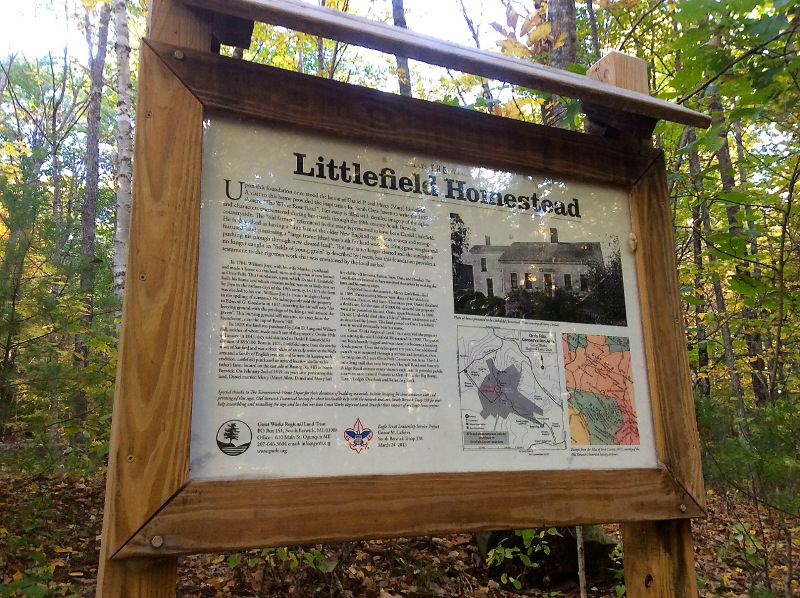
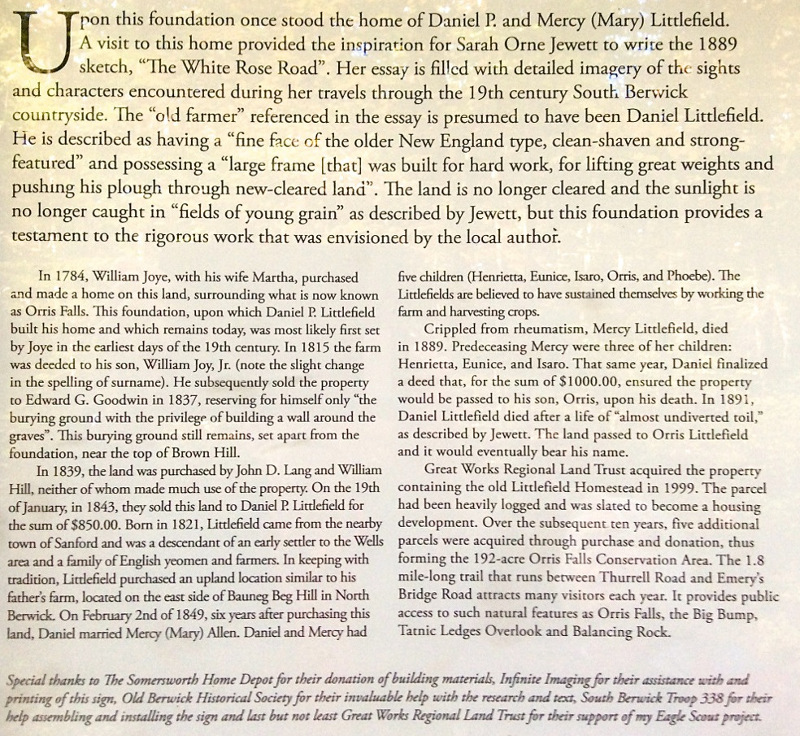
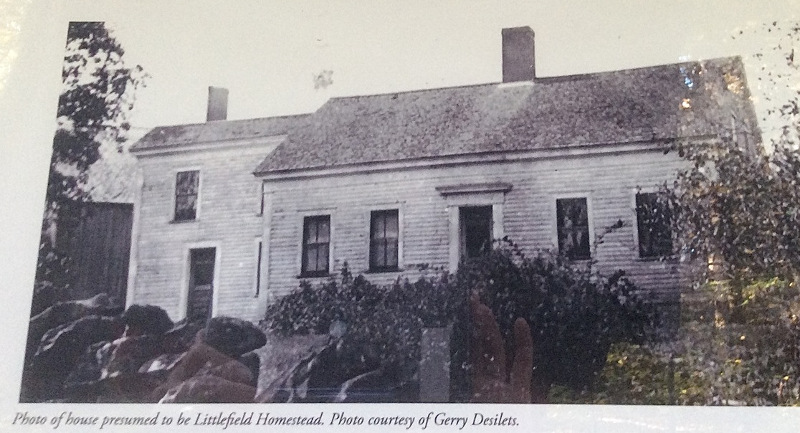
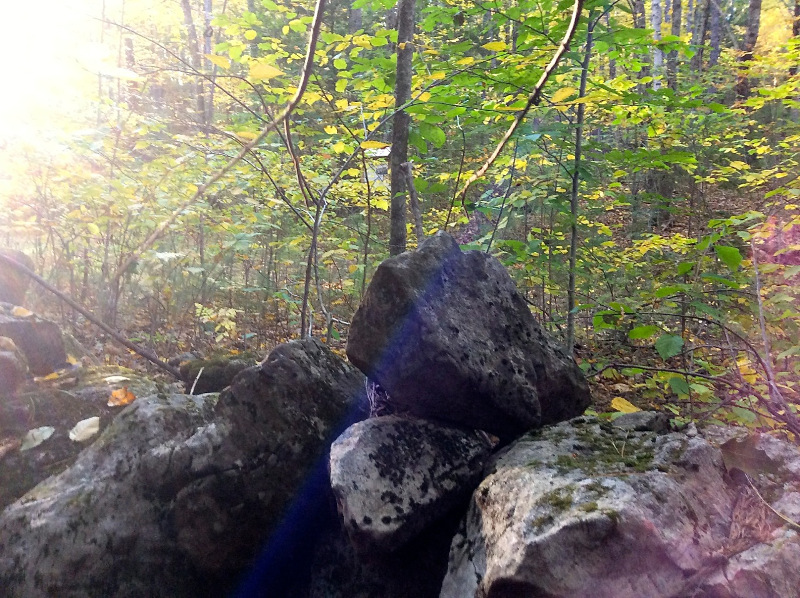
This is probably the rock wall in the foreground of the above photograph of the homestead.
In that photo, the woods were cleared and the house could be seen.
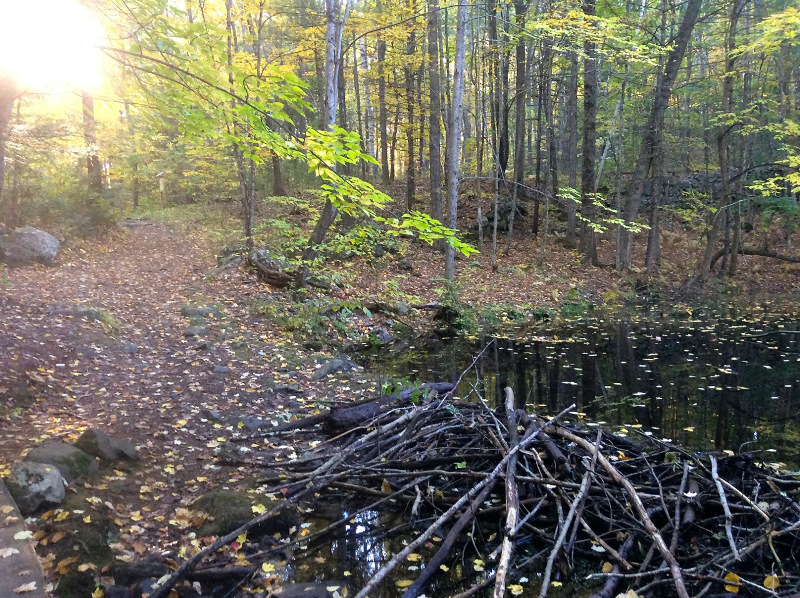
The Littlefield rock wall is on the left side of this lane.
The sign in front of the foundation is on the right side of the lane.
Beavers are damming the wetlands near the foundation.
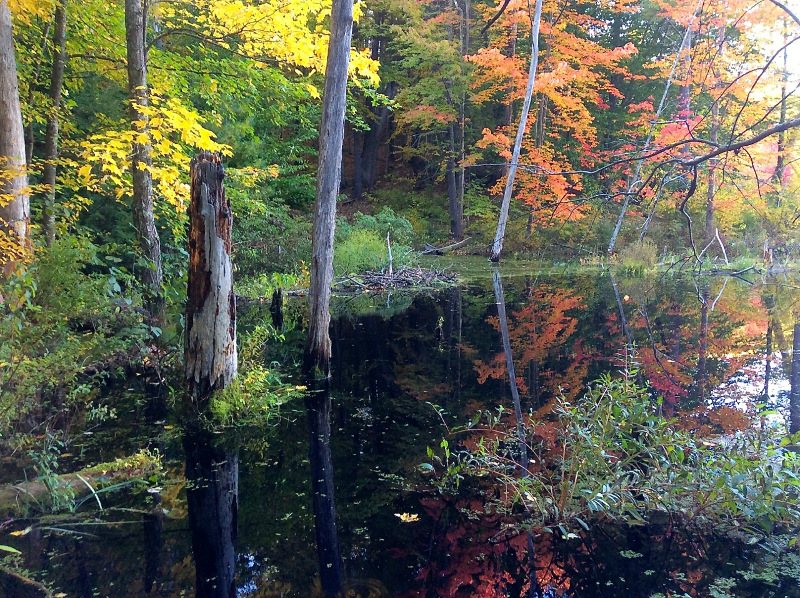
Another beaver dam in the nearby upper part of the wetlands.